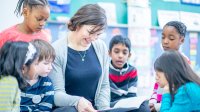Teaching Elementary Students About the Concept of Injustice
Students gain a rich understanding of civil rights when they build from their ideas of fairness to the larger issue of justice.
Your content has been saved!
Go to My Saved Content.Anyone who’s spent time on an elementary school playground knows that young children already know a lot about injustice. He took the tire swing from me! She cut in front of me in line! They won’t let me play. That’s not fair! And so it goes. Injustice is something children see every day, and fairness is something they care deeply about.
Early elementary school is the ideal time to build on children’s natural awareness of fairness and justice. I do it by taking a look outside of the schoolyard and into our country’s history and present circumstances when fairness is not necessarily the norm.
In first grade, during Women’s History Month, I introduce a social studies unit called Justice Heroes. I always launch the unit with some sort of exercise that prompts my students to think hard about what fairness is (and how upsetting unfairness can be). From there we create a chart and write down responses to the following essential questions that will guide the unit:
- What is fairness?
- What does it mean to work for justice?
- What are the characteristics of a Justice Hero?
Age-Appropriate Ways to Teach the Concept of Injustice
Introduce ‘Young Justice Heroes’: Using examples of young people who have stood up to injustice in the past is a great way to help children see that even young children can make a difference in the world. Check out a short video from Scholastic called Can Kids Change the World, about a brave 7-year-old girl who participated in a lunch counter sit-in during the civil rights movement. Another example is a video about Ruby Bridges, one of three young girls (the McDonogh Three) who desegregated their public school in Louisiana in 1960.
Make a timeline: After learning about these young Justice Heroes, children can create a timeline of their own lives to reflect on important events that have happened in their lifetime and times when they had to be brave. They can draw pictures of something that happened when they were born (e.g., the rise to prominence of the Black Lives Matter protest movement in 2015), something important that happened in the recent past, and something that is happening today. Defining terms such as “in the past,” “in the present,” and “in the future” is important for helping young children understand what it means to study people and events in history.
Define fairness: Children usually have lots of ideas and anecdotes about what fairness means. A video about fairness can prompt them to think about and discuss what it means to be treated fairly. Have them write and draw what they believe fairness looks like, both on the playground and in the world around us. Students can share their stories or even act them out for the class.
Introduce books about Justice Heroes: Choose quality read-aloud books about real people from different ethnicities and historical periods who worked for equality, and read one every day. Reading true stories can inspire children to see what is possible when one works for justice. Try these:
- Elizabeth Cady Stanton, activist for women’s voting rights: Elizabeth Leads the Way, by Tanya Lee Stone
- Esther Morris, first woman justice of the peace: I Could Do That!, by Linda Arms White
- Sojourner Truth, abolitionist and women’s rights activist: So Tall Within, by Gary Schmidt
- Emma Lazarus, Jewish American author and activist: Emma’s Poem, by Linda Glaser
- Abraham Lincoln: I Am Abraham Lincoln, by Brad Meltzer
- Jackie Robinson, first Black man to play in baseball’s major leagues: Teammates, by Peter Golonbock
- Ayanna Najuma, civil rights activist: Freedom on the Menu, by Carole Boston Weatherford
- Ruby Bridges, civil rights activist: The Story of Ruby Bridges, by Robert Coles
- Dolores Huerta and Cesar Chavez, labor and civil rights activists, Side by Side, by Monica Brown
Create a Justice Heroes comic book: Using evidence from the texts above, describe each hero’s qualities and distinctive traits. Define essential words like equality, segregation, injustice, boycott, protest, immigration, courage, and achievement. I like to engage my students in a discussion about how being fair means doing something good for everyone involved, as well as about how fairness is fundamental to justice.
Look for ways our heroes showed courage and fairness in working for justice. Have the kids brainstorm words that our Justice Heroes might have said to lead others to justice, like “These people will be free!” “Women have every right to vote!” “Sí, se puede!”
From there, have each student create a comic book page dedicated to just one Justice Hero each day. Then, at the end of the unit, each student has their own comic book capturing the stories of all the Justice Heroes.
Make a Justice Hero timeline: Create a timeline that places each Justice Hero in the order of events that took place in American history. On the last day of the unit, try reading about a person working for justice in the present; I like to use the video of Vice President Kamala Harris reading aloud her book Superheroes Are Everywhere. Recite the Hero Pledge from her book so that every kid is inspired to think about how they can wear their own super cape someday. Finish the activity by having each child add a picture of themselves to the Justice Hero timeline for in the future.
Make a mobile: As a closing project, each child can choose their favorite Justice Hero and make a cardboard cutout of the person. They can write a few sentences explaining why they admire that individual and how they saw them show courage in fighting for justice. Hang the cutouts in the classroom so that Justice Heroes from the past and present fill the classroom.
